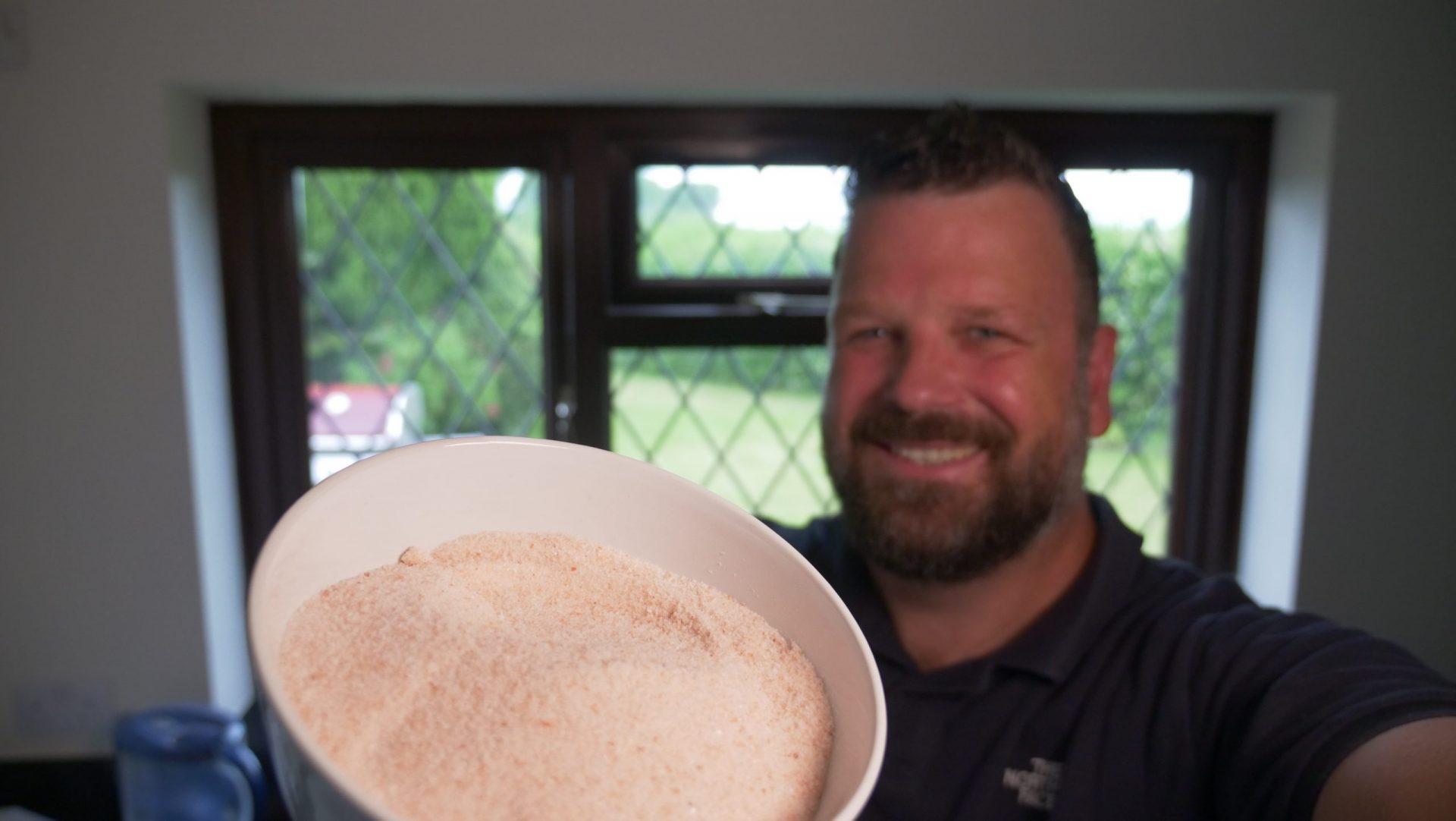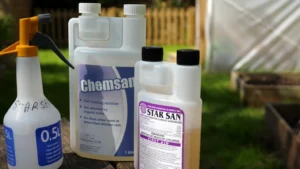When fermenting, salt is hugely important. Not only does it help preserve flavour and vitamin content, but it keeps away unwanted bacteria, resulting in a healthy fermentation.
Two Common Questions About Salt
Two questions commonly arise when talking about salt in fermentations. What type of salt, and how much.
What Type of Salt Should I Use for a Fermentation?
Firstly lets talk about the type of salt. You would have heard me mention during my videos to use salt that has no additives, and also salt that is not iodised. While I still prefer to use salt like sea salt or Himalayan rock salt, research shows that iodised salt will not actually affect the success of your fermentation.
The use of iodized salt did not statistically significantly influence microbial populations in the fermentation. Thus, there is no basis for the popular held belief that the use of iodized salt inhibits the growth of the bacteria important for the sauerkraut fermentation.
https://www.sciencedirect.com/science/article/abs/pii/S0740002018300121
I would still steer away from salt that has additives like anti-caking agents.
How Much Salt Should I Use for a Fermentation?
Secondly, the amount of salt to use. Salt in fermentations is usually expressed as a percentage. For a brine fermentation, this is a percentage of the weight of the water only. So 3% salt would be 30g salt with 1000g water (1000ml). With a mash fermentation, you measure the weight of the ingredients and use the appropriate amount of salt. So 30g salt for 1000g or 1kg of chillies.
There are two things to consider when adding salt. How salty the end product will be, you can always add salt, but you can’t take it away! And the amount of salt that allows the lactobacillus to thrive but also inhibits harmful bacteria.
My recommendation is to go with between 2 and 3% once you are comfortable with making fermentations. If you are just starting out and want to be a little more cautious, you can use up to 5 or even 6%.
Lactobacillus can tolerate salt levels up to about 8 to 10%. However after 6% the lactobacillus activity is markedly reduced.
Four Lactobacillus species were studied for their ability to grow at high NaCl concentrations and different initial pH values. Among these strains, Lactobacillus plantarum strains 541 and A6 indicated to be the most salt tolerant. Both strains were able to ferment glucose up to 8% salt and produce lactic acid even at 10% salt
https://core.ac.uk/download/pdf/36062836.pdf





Hey Shaun, I had two quick questions.
I made a hot sauce last year following one of your videos that turned out really well. One concern I did have at first was how salty it was. Q1: Am I supposed to rinse off the pepper pieces after I strain the brine out? I didn’t use any brine in my recipe, just peppers and then I ended up adding some distilled water to thin it out and sugar to balance out the salt. After I did those, it didn’t taste salty at all. But I’m worried because this year I used 50g/L salt by mistake instead of 35g like I did last year.
Q2: Is it ok to remove the airlock to push pepper pieces back under the fermentation weights? Idk if it would be better to leave the airlock sealed the whole time and remove a floating moldy piece at the end or undo the airlock and let oxygen get back in but have all the peppers under the brine.
Thanks so much for any help!
Chris
Hi Chris,
My general recommendation for a traditional fermentation is between 2% and 3% salt. A common mistake I see is when people do a brine fermentation, they weigh the ingredients as well as the water when determining the salt content. You only need to weigh the water. But it seems like you are doing that already. Try reducing the amount of salt to 2.5%. This should not be too salty at all. In face, I usually find I need to add a little extra salt when processing my sauces.
I wouldn’t mess around too much with the fermentation, especially in the first week while the lactobacillus is becoming the dominant culture. Rather just give the jar/container a swirl each day to coat everything with the brine again.
Thanks for your reply Shaun. I actually meant that I used 25g/L last year, not 35g/L.
I have one more related follow-up question. It’s been over 10 days with this “oopsie” 50g/L batch now and I’ve seen zero signs of fermentation. I wrote “airlock” in the last post for simplification but I’m actually using platic bags with rubber bands. Last year they inflated after 3 days. This year, nothing.
Is it possible to salvage this? What if i dump all of the peppers out, rinse the salt out with spring or distilled water, and put them back in jars with the proper 25g/L solution? Or is it too late for fermentation? If that’s the case, is it advisable to pull the peppers out and blend them up with vinegar to make a sauce that way? I don’t see any mold in the jars. The brine has changed from clear to cloudy yellow, but nothing unusual. What do I do now?
Thanks again for your help. Really appreciate it.
i have everything ready to go….i just need to know …. what temp you have your fridge at??? im assuming the point is a dark cool place? how cool? or how warm is to warm?? i donnt have a secondary fridge ..thanks in advance
It’s a modified fridge that I use. Ferminator
https://youtu.be/nMMbdDRJaUY
You want a dark place, but you also need a consistent temperature for best results. Under 19’C and you won’t have an active fermentation…too high and you will have off flavours. Room temperature is fine…but I use my Ferminator to get the best results.
i have it room temp at a fairly stable 18 to 19 …so that will be good ..its on day 2 of the fermentation and im hoping i didnt mess up to bad…i think i overfilled the 1 liter mason jar ..as it has now begun to make bubbles and things just like it is supposed to but the liquid it has made filled my water airlock and over flowed it …i gently tipped it over and poured out the now slightly red water out to the proper level for the airlock …. i made sure to not allow air in when doing so ..only bubbles were coming out ..nothinng went in…is this something to be concerned about or should i just place a dish under it and allow it to flow as it will? there would appear to now be no room left up top of the jar? very little if there is …
would it be a terrible idea to open and remove an inch of mash ?? or like question asked earlier just place it in a bowl and allow to flow as she will?? thanks for your time man i watch all your stuff
i just wrote a reply to your reply lol but now i dont see anything on here so here we go again…
i used a 1 liter mason jar with a water air lock ..made a peppermash out of homegrown ring of fire and cayenne..it is day 2 of the ferm and i believe i over filled the jar as now that it has been creating the perfect looking gas pockets as yours was..it has now entirely fill the jar with water and expanded mash and has filled the airlock with some red peppery water and over filled and over flowed from the airlock with the water created by the salt and pepper mash so my question is …. is my ferm garbage now ? can i open the jar and scoop out an inch of mash?? i carefully poured out some of the created liquid by tipping the jar a bit and allowing the gases and liquid to expel through the airlock making sure that no air bubbles went into the jar only out of the jar… should i open and remove some ..or should i just place this ferm in a bowl and allow it to overflow as it will?? i have it in the dark at room temp around 19 degrees
tell me i can save this?!?! i would hate to lose this years yield ! i just dont know to open …or just make sure that it can always continue to over flow the created liquids out the the top of the airlock .. thanks alot man ..i watch all your stuff
Hey Devon, If you send me and my team a message through chillichump.com/contact you will get a quicker reply!
You can clean out the airlock, and then sanitise it again before replacing it in the jar. If you don’t have a no-rinse sanitiser like I use, then use some distilled vinegar. You should be fine!
Help!
Hi there
I am new to fermentation , just reading the interesting posts.
Do i leave the chillies whole , or do i grind them .
Also when making the brine , if my salt is about 1 +1/4 tsp per litre of water ,how much of chillies do i take.
First time i am attempting something like this .
Thank You
Hello Rasheeda,
I would recommend having a look at some of my videos where I cover off these things as well as some other helpful topics:
Mash vs brine
https://youtu.be/1IyrvH-Gexk
Clean, sanitise, sterilise
https://youtu.be/R7SSisK-uUk
Make your own fermenting containers
https://youtu.be/Sz-I4jlm9mc
Is my fermentation safe
https://youtu.be/SIPAqoxF710
Minimum ferment time
https://youtu.be/VZt7PY8ESg4
Maximum ferment time
https://youtu.be/6wdkVQJbNwQ
Hi Shaun!
Loving your content, I’m a first time chilli farmer. I plan on making a sauce later this year after fermenting.
In your videos you refer to sauces being ‘shelf stable’, can you elaborate on how long they’re ‘stable’ for?
Once opened I’m assuming they go in the fridge and consumed within 1-2 months.
Stay spicy!!
I’m confused about vinegar. Will vinegar kill the lacto bacillus? I thought the idea was to get the probiotic benefit of fermented peppers?
Thanks Boet!